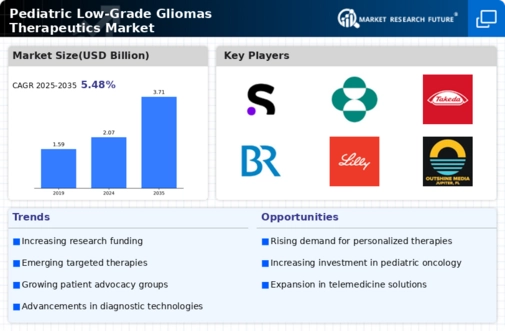Advancements in Diagnostic Techniques
Advancements in diagnostic techniques significantly influence the Pediatric Low-Grade Gliomas Therapeutics Market. Enhanced imaging technologies, such as MRI and PET scans, allow for earlier and more accurate detection of low-grade gliomas in children. This early diagnosis is crucial, as it enables timely intervention and treatment, which can improve patient outcomes. The integration of advanced molecular diagnostics also aids in the identification of specific tumor types, facilitating personalized treatment approaches. As diagnostic capabilities continue to evolve, the demand for targeted therapies tailored to individual patient profiles is likely to increase. This trend not only enhances treatment efficacy but also drives the growth of the Pediatric Low-Grade Gliomas Therapeutics Market, as healthcare providers seek to implement the most effective therapeutic strategies based on precise diagnostic information.
Growing Investment in Pediatric Oncology Research
The growing investment in pediatric oncology research serves as a significant catalyst for the Pediatric Low-Grade Gliomas Therapeutics Market. Increased funding from both public and private sectors has led to a surge in clinical trials aimed at developing novel therapeutic agents for pediatric low-grade gliomas. For instance, recent reports indicate that funding for pediatric cancer research has seen a substantial rise, with millions allocated specifically for low-grade glioma studies. This influx of capital not only accelerates the pace of research but also fosters collaboration among academic institutions, pharmaceutical companies, and healthcare organizations. As a result, the Pediatric Low-Grade Gliomas Therapeutics Market is likely to benefit from the introduction of innovative therapies that emerge from these research initiatives, ultimately improving treatment options for affected children.
Regulatory Support for Pediatric Drug Development
Regulatory support for pediatric drug development plays a crucial role in shaping the Pediatric Low-Grade Gliomas Therapeutics Market. Regulatory agencies are increasingly recognizing the need for tailored therapies for children, leading to the establishment of guidelines that facilitate the development and approval of pediatric-specific treatments. Initiatives such as the Pediatric Research Equity Act encourage pharmaceutical companies to prioritize research in pediatric populations, thereby enhancing the availability of effective therapies for low-grade gliomas. This supportive regulatory environment not only streamlines the approval process but also incentivizes investment in pediatric oncology. As a result, the Pediatric Low-Grade Gliomas Therapeutics Market is likely to experience growth as more companies engage in the development of innovative treatments that meet regulatory standards and address the unique needs of pediatric patients.
Rising Awareness and Advocacy for Pediatric Cancer
Rising awareness and advocacy for pediatric cancer significantly impact the Pediatric Low-Grade Gliomas Therapeutics Market. Increased public awareness campaigns and advocacy efforts have led to a greater understanding of pediatric low-grade gliomas among healthcare professionals and the general public. This heightened awareness encourages early diagnosis and treatment, which is essential for improving patient outcomes. Additionally, advocacy groups play a vital role in funding research and supporting families affected by these tumors. As more individuals become informed about the challenges associated with pediatric low-grade gliomas, there is likely to be a corresponding increase in demand for effective therapeutic options. Consequently, the Pediatric Low-Grade Gliomas Therapeutics Market is expected to grow as stakeholders respond to the needs of patients and families seeking better treatment solutions.
Increasing Incidence of Pediatric Low-Grade Gliomas
The rising incidence of pediatric low-grade gliomas is a pivotal driver for the Pediatric Low-Grade Gliomas Therapeutics Market. Recent data indicates that these tumors account for approximately 30 percent of all pediatric central nervous system tumors. This increasing prevalence necessitates the development of effective therapeutic options, thereby propelling market growth. As awareness of these conditions expands, healthcare providers are more likely to seek innovative treatments, which could lead to a surge in demand for targeted therapies. Furthermore, the growing number of diagnosed cases may stimulate research and development efforts, encouraging pharmaceutical companies to invest in this niche market. Consequently, the Pediatric Low-Grade Gliomas Therapeutics Market is poised for expansion as stakeholders respond to the urgent need for effective treatment solutions.

















Leave a Comment